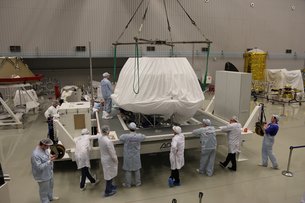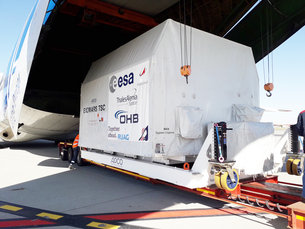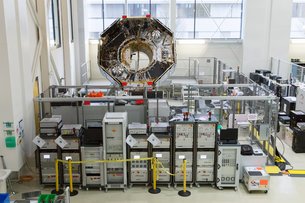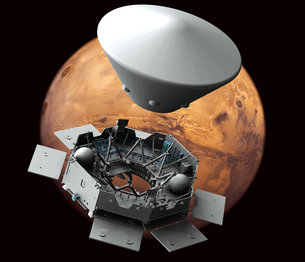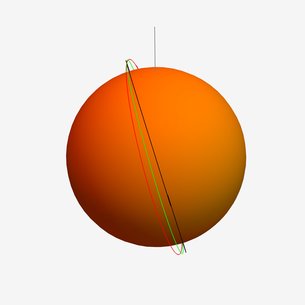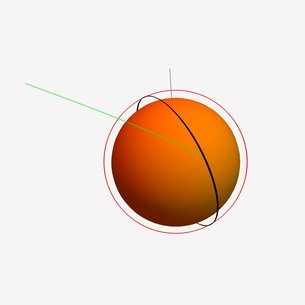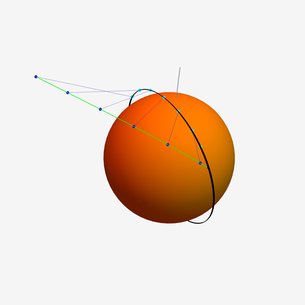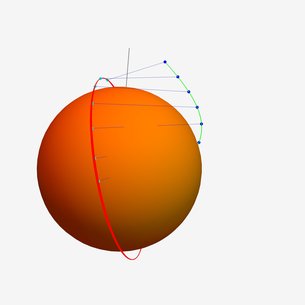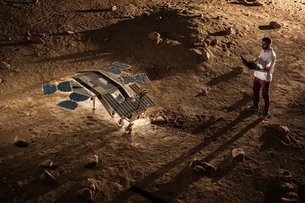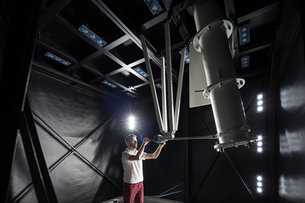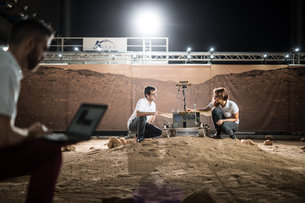23.03.2019
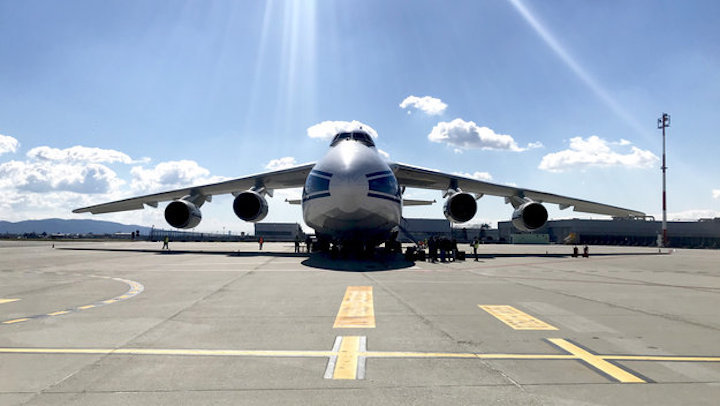
EXOMARS LANDING PLATFORM ARRIVES IN EUROPE WITH A NAME
The platform destined to land on the Red Planet as part of the next ExoMars mission has arrived in Europe for final assembly and testing – and been given a name.
An announcement was made by the Russian State Space Corporation Roscosmos of its new name: ‘Kazachok’.
The ExoMars programme is a joint endeavour between ESA and Roscosmos and comprises two missions. The Trace Gas Orbiter is already circling Mars examining the planet’s atmosphere, while the second mission – comprising a surface science platform and a rover – is foreseen for launch in 2020.
Last month, the rover was named ‘Rosalind Franklin’ after the prominent scientist behind the discovery of the structure of DNA. Now the surface platform also has a name. Kazachock literally means little Cossack, and it is a lively folk dance.
Once on the martian surface, Rosalind the rover will drive off the Kazachok platform to perform scientific investigations. Kazachok will remain stationary to investigate the climate, atmosphere, radiation and possible presence of subsurface water in the landing site.
Welcome to Europe
Kazachok left Russia after being carefully packed to meet planetary protection requirements, making sure to not bring terrestrial biological contamination to Mars. It was shipped to Turin, Italy, on an Antonov plane along with ground support equipment and other structural elements.
The Italian division of Thales Alenia Space will perform final assembly and testing of the mission in close cooperation with ESA and the Russian Lavochkin Association, the developer and manufacturer of the descent module including the landing platform.
There will be more components arriving to Italy throughout the year, including avionics equipment, the carrier and rover modules and thermal protection systems for the landing platform.
Several test campaigns with ExoMars models are running in parallel in preparation for launch and landing.
Recent shock tests in Russia have successfully proved the mechanical compatibility between the spacecraft and the adapter for the Proton-M rocket that will set ExoMars on its way to Mars.
The ExoMars teams have also just completed the egress and locomotion tests with a full-sized model of the rover in Zurich, Switzerland.
There the rover drove off ramps and through all the terrain conditions that it might encounter on Mars: different types of soil, various obstacle shapes and sizes and all kind of slopes.
“We have now a very challenging schedule of deliveries and tests both in Italy and France. The coordination between the Russian and European teams is key to timely reach the Baikonur cosmodrome in 2020,” says François Spoto, ESA’s ExoMars team leader.
Quelle: ESA
----
Update: 6.04.2019
.
EXOMARS CARRIER MODULE PREPARES FOR FINAL PRE-LAUNCH TESTING

The module that will carry the ExoMars rover and surface science platform from Earth to Mars has arrived in Italy for final integration preparations.
The module, along with electrical ground support equipment, shipped from OHB System in Bremen, Germany, arrived on 2 April at Thales Alenia Space in Turin, Italy.
The mission is the second in the joint ESA-Roscosmos ExoMars programme that is exploring the possibility of whether life has ever existed on Mars.
The Trace Gas Orbiter is already at Mars, analysing the planet’s atmosphere, and mapping subsurface water. It will also act as a data relay for the next mission, which is scheduled to launch in July 2020, delivering a rover and surface science platform to the Red Planet in March 2021.
The carrier module also provides the communication link between Earth and the spacecraft, and will support navigation with star trackers and Sun sensors. It also carries propellant required for attitude control and manoeuvres through its 16 20-N thrusters that will use up to 136 kg of hydrazine propellant.
The landing platform, named Kazachok, also recently arrived in Europe from Russia, while the rover, named after Rosalind Franklin, is being fitted out with its scientific instruments at Airbus in Stevenage, UK.
“This is an important milestone, as the carrier module is the ‘vessel’ that will take Rosalind Franklin all the way to Mars,” says Thierry Blancquaert, ESA ExoMars spacecraft systems engineering team leader.
During the nine-month interplanetary journey, the 800-kg carrier module will transport Kazachok and Rosalind the rover within a single, 2-tonne descent module, providing electrical power via a solar array.
The solar panels will generate about 2 kW of power, up to 400W of which can be provided to the descent module; energy is stored in a 24,4-kg battery.
“During the cruise to Mars, the Carrier Module provides all resources to the descent module and rover,” says Stéphane Langlois, ExoMars spacecraft systems engineer at ESA.
“Upon approach to the Red Planet, the carrier module plays a critical role to ensure that the descent module is delivered in the best possible conditions for a successful entry.”
Telemetry and data will be stored and transmitted via the onboard computer located in the descent module.
The descent module, which does not produce any power by itself during launch and transfer, will separate from the carrier module shortly before reaching the martian atmosphere. The descent module will deliver the rover and platform safely to the surface while the carrier module will burn up in the atmosphere.
In the coming months, the carrier module will be mated with the descent module.
The resulting composite spacecraft will then undergo further testing to ensure it is ‘qualified’ for its launch into the space environment.
“We are thrilled to see all components finally coming together and we are looking forward to the next phase of testing ahead of launch next year,” says François Spoto, ESA’s ExoMars team leader.
Quelle: ESA
----
Update: 9.04.2019
.
ExoMars carrier module prepares for final pre-launch testing

The module that will carry the ExoMars rover and surface science platform from Earth to Mars arrived on 2 April at Thales Alenia Space in Turin, Italy, from OHB System in Bremen, Germany. The carrier module also provides the communication link between Earth and the spacecraft, and will support navigation with star trackers and Sun sensors. It also carries propellant required for attitude control and manoeuvres after launch and during cruise by means of its16 20-N thrusters that will use up to 136 kg of hydrazine propellant.
The module that will carry the ExoMars rover and surface science platform from Earth to Mars has arrived in Italy for final integration preparations.
The module, along with electrical ground support equipment, shipped from OHB System in Bremen, Germany, arrived on 2 April at Thales Alenia Space in Turin, Italy.
The mission is the second in the joint ESA-Roscosmos ExoMars programme that is exploring the possibility of whether life has ever existed on Mars.
The Trace Gas Orbiter is already at Mars, analysing the planet's atmosphere, and mapping subsurface water. It will also act as a data relay for the next mission, which is scheduled to launch in July 2020, delivering a rover and surface science platform to the Red Planet in March 2021.
The carrier module also provides the communication link between Earth and the spacecraft, and will support navigation with star trackers and Sun sensors. It also carries propellant required for attitude control and manoeuvres through its 16 20-N thrusters that will use up to 136 kg of hydrazine propellant.
The landing platform, named Kazachok, also recently arrived in Europe from Russia, while the rover, named after Rosalind Franklin, is being fitted out with its scientific instruments at Airbus in Stevenage, UK.
"This is an important milestone, as the carrier module is the 'vessel' that will take Rosalind Franklin all the way to Mars," says Thierry Blancquaert, ESA ExoMars spacecraft systems engineering team leader.
During the nine-month interplanetary journey, the 800-kg carrier module will transport Kazachok and Rosalind the rover within a single, 2-tonne descent module, providing electrical power via a solar array.
The solar panels will generate about 2 kW of power, up to 400W of which can be provided to the descent module; energy is stored in a 24,4-kg battery.
"During the cruise to Mars, the Carrier Module provides all resources to the descent module and rover," says Stephane Langlois, ExoMars spacecraft systems engineer at ESA.
"Upon approach to the Red Planet, the carrier module plays a critical role to ensure that the descent module is delivered in the best possible conditions for a successful entry."
Telemetry and data will be stored and transmitted via the onboard computer located in the descent module.
The descent module, which does not produce any power by itself during launch and transfer, will separate from the carrier module shortly before reaching the martian atmosphere. The descent module will deliver the rover and platform safely to the surface while the carrier module will burn up in the atmosphere.
In the coming months, the carrier module will be mated with the descent module.
The resulting composite spacecraft will then undergo further testing to ensure it is 'qualified' for its launch into the space environment.
"We are thrilled to see all components finally coming together and we are looking forward to the next phase of testing ahead of launch next year," says Francois Spoto, ESA's ExoMars team leader.
Quelle: SD
----
Update: 29.05.2019
.
EUROPE TO MARS – AND BACK!
Has there ever been life on Mars? Reconstructing the history of our neighbouring planet and understanding how its evolution diverged from that of Earth is at the heart of Mars exploration missions.
ESA’s first journey on this quest began 16 years ago – on 2 June 2003, with the launch of Mars Express. The orbiter has imaged almost all of the planet’s surface to date and continues to return a wealth of scientific data, including evidence for its wetter past. And where there was water there may have been life.

In 2016, ESA and Roscomos launched the 3.7 tonne ExoMars Trace Gas Orbiter (TGO), the heaviest spacecraft operating at Mars today. Dedicated to analysing the planet’s atmosphere in greater detail than ever, it is making a census of the gases present and to find out if any have a biological or geological origin. The spacecraft is also providing a global map of water distribution in terms of water-ice or water-hydrated minerals in the shallow sub-surface of Mars.
TGO is also a key provider of data-relay services to NASA’s Insight lander and Curiosity rover on the surface of Mars. It will be the primary communications relay for the second ExoMars mission, which comprises a rover and surface science platform. It is on track for launching in July 2020 and will arrive at Mars in March 2021. TGO is already getting ready for the new arrival: next month it will make adjustments to its orbit to ensure it will be in the correct position to support the entry, descent and landing of the descent module.
After driving off the surface platform and studying its surrounds, the rover, named Rosalind Franklin, will locate scientifically interesting sites to examine. It will retrieve samples from 2 m below the ground, where they are protected from the harsh radiation that bombards the surface, for analysis in its highly advanced onboard laboratory to search for evidence of life.

NASA’s 2020 Mars rover will also land in early 2021 to explore the delta of an ancient river. Alongside its own scientific goals, it will collect and store soil samples in pen-sized canisters, ready for a future pickup and return to Earth – the next logical step in the robotic exploration of Mars.
The Mars Sample Return concept needs three different missions and an international effort; Europe is a key partner and NASA’s 2020 rover is just the first step. ESA is studying concepts for a small and agile ‘fetch’ rover to recover the stored samples and carry them to a football-sized canister to launch from a NASA-led landing platform and Mars ascent vehicle. A third mission would be an ESA-led spacecraft sent from Earth to Mars orbit that will locate the orbiting canister, capture it and return it safely to Earth.
The Earth return orbiter will use technological heritage from ESA’s most recently launched science mission, BepiColombo: both use electric propulsion and multi-stage detachable modules. To catch the canister of samples, it will also use technological heritage in autonomous rendezvous from the European-built Automated Transfer Vehicles that supplied the International Space Station with cargo, fuel and oxygen.

Like the return of Moon rocks to Earth, bringing back samples of Mars will be a defining moment in space exploration. In this first Mars Sample Return mission, around 500 grams of material could be collected from diverse sites. Once returned to Earth, the samples would be curated in special facilities, ensuring compliance with planetary protection requirements. Bringing samples back to Earth will facilitate studies that are simply not possible in the miniaturised rover laboratories – however sophisticated – and, perhaps more importantly, will enable future discoveries as analytical techniques improve over time.
Looking in further ahead, the martian environment needs to be better understood before humans visit the Red Planet. Returned samples would not just be of scientific value but would help assess hazards related to the dust in the soil – relevant for human health issues and for operating engineering equipment in a dusty environment. The samples would also help inform how to use resources on the planet, an essential aspect of creating a self-sufficient environment for long-duration stays on Mars.
Europe is also participating in JAXA’s Martian Moons Exploration mission that will survey the two moons of Mars and bring a sample from Phobos back to Earth, to better understand the origin of the planet’s moons.
“While we continue to maximise the science return from our two Mars orbiters, we are also gearing up for a safe landing and roving across the planet’s surface,” says David Parker, ESA’s Director of Human and Robotic Exploration.
“To secure our future in Mars exploration, looking towards human exploration of the Red Planet, we are already planning the next logical steps – a robotic sample return mission as the first round-trip to the surface of Mars. NASA’s 2020 rover mission will soon be in place as the first step of this challenging mission. Now we want to finish it.”
ESA has demonstrated expertise in studying Mars from orbit, now we are looking to secure a safe landing, to rove across the surface and to drill underground to search for evidence of life. Our orbiters are already in place to provide data relay services for surface missions. The next logical step is to bring samples back to Earth, to provide access to Mars for scientists globally, and to better prepare for future human exploration of the Red Planet. This week we’re highlighting ESA’s contribution to Mars exploration as we ramp up to the launch of our second ExoMars mission, and look beyond to completing a Mars Sample Return mission. Join the conversation online with the hashtag #ExploreFarther
Quelle: ESA
----
Update: 31.05.2019
.
Rosalind Franklin: Mars rover control centre opens

The control centre that will run day-to-day operations during the Rosalind Franklin rover's exploration of Mars in 2021 has been inaugurated in Turin.
The Italian facility will be where engineers sit and communicate with the robot vehicle via a satellite that is already in orbit around the Red Planet.
Rosalind Franklin is a joint venture between the European and Russian space agencies (Esa and Roscosmos).
Its mission is to drill into Mars to see if life has ever been present.
Esa's director-general, Jan Wörner, said of the new Rover Operations Control Center (ROCC): "This is the crucial place on Earth from where we will listen to the rover's instruments, see what [Rosalind Franklin] sees and send commands to direct the search for evidence of life on and under the surface."
The ROCC is located on the premises of Altec, an engineering and logistics services company set up by the Italian Space Agency and Thales Alenia Space (TAS).
TAS is the industrial prime contractor engaged by Esa to develop the rover and all its systems.
Assembly of the vehicle itself has been subcontracted to another of Europe's major aerospace companies, Airbus.
Final integration of the six-wheeled scientific machine is nearing completion in a cleanroom in Stevenage, UK.
Three rovers are actually being constructed as part of the mission.
The first, called the "Structural Thermal Model" (STM), was used to prove the design.
This STM went through a tough testing regime to check that the robot that does eventually launch to Mars - the "Flight Model" now in Stevenage - will be able to cope with the stresses of working on another planet.
The third model, also not quite finished, is called the "Rover Ground Test Module".
This is essentially the copy of Rosalind Franklin that will be kept on Earth at the ROCC to troubleshoot any problems.
If engineers need to re-write a piece of software to overcome some glitch on the Flight Model, the patch can be trialled first in the Turin Test Module before being sent up to the Red Planet.
Some problems may be more physical in nature, such as an obstacle like a sand trap or large boulder.
Again, the ROCC's engineers will be able to practise avoidance and escape manoeuvres with a dummy rover model in a large sandpit before asking the real robot on Mars to follow the same movements.
Rosalind Franklin is due to launch to the Red Planet in July/August next year and land in March 2021.

The rover's name: Who was Rosalind Franklin?
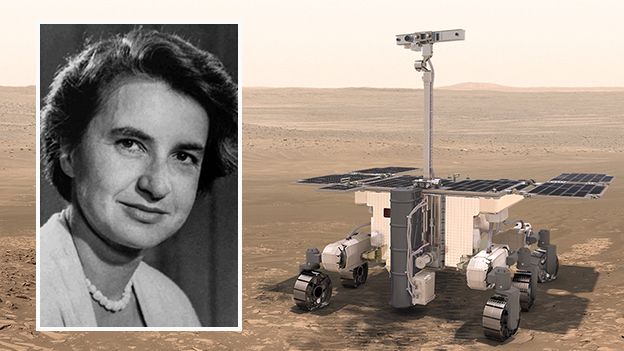 Image copyrightGETTY IMAGES/ESA
Image copyrightGETTY IMAGES/ESA
In 1952, Rosalind Franklin was at King's College London (KCL) investigating the atomic arrangement of DNA, using her skills as an X-ray crystallographer to create images for analysis.
One of her team's pictures, known as Photo 51, provided the essential insights for Crick and Watson to build the first three-dimensional model of the two-stranded macromolecule.
It was one of the supreme achievements of 20th Century science, enabling researchers to finally understand how DNA stored, copied and transmitted the genetic "code of life".
Crick, Watson, and KCL colleague Maurice Wilkins received the 1962 Nobel Prize for the breakthrough.
Franklin's untimely death meant she could not be considered for the award (Nobels are not awarded posthumously). However, many argue that her contribution has never really been given the attention it deserves, and has even been underplayed.
Quelle: BBC
+++
EXOMARS ORBITER PREPARES FOR ROSALIND FRANKLIN
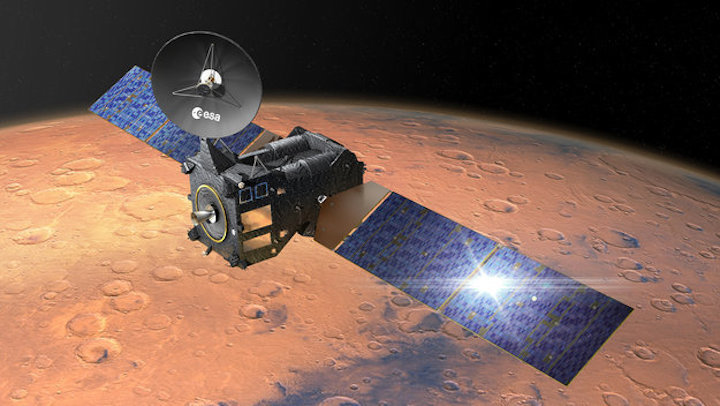
On 15 June, the ESA-Roscosmos ExoMars Trace Gas Orbiter (TGO) will follow a different path. An ‘Inclination Change Manoeuvre’ will put the spacecraft in an altered orbit, enabling it to pick up crucial status signals from the ExoMars rover, Rosalind Franklin, due to land on the Red Planet in 2021.
After completing a complex series of manoeuvres during 2017, ExoMars TGO is now orbiting the Red Planet every two hours, collecting scientific data from NASA’s surface-bound rover and lander, and relaying it back to Earth. At the same time, the orbiter is gathering its own data on the planet’s atmosphere, water abundance and alien surface.
More than a year before Rosalind even lifts off from Earth’s surface, flight dynamics experts at ESA’s ESOC mission control centre have formulated a long-term plan to ensure ExoMars TGO can communicate with the new ESA rover and surface platform, contained in the entry, descent and landing module.
Slight changes to a spacecraft’s orbit have a large effect over time, so while the upcoming manoeuvres will only slightly alter TGO’s speed, it will be in the right position to communicate with the then-incoming rover by 2021.
TGO’s natural motion
Mars’ uneven gravity field means that TGO’s orbit ‘wanders’, so it gradually rotates around Mars over time. As illustrated in this image, the spacecraft first follows the black path, then the green, then the red – continuing until it completes an entire rotation around the planet every four and a half months.
To keep in touch with the descent module as it enters the Martian atmosphere, descends, and lands upon its surface, TGO’s orientation needs to change.
Three manoeuvres in the month of June will alter TGO’s speed, twice by 30.9 metres per second and one final small change of 1.5 metres per second, bringing it slightly closer to the Martian poles.
Inclined to fly
Thanks to these manoeuvres, TGO’s path will look more like the second graphic shown here, illustrating ‘snapshots in time’ during the 2021 descent of the new rover.
The green line represents Rosalind Franklin’s landing approach path.
The black line shows the TGO orbit with its optimised orientation, two years after the upcoming manoeuvres.
The red path shows TGO’s original orbit.
In-phase with Rosalind Franklin
Once TGO is set to orbit with its new, optimised orientation around Mars, teams on the ground must also ensure it will be on the correct side of the planet when the rover arrives – ‘in phase’ with Rosalind Franklin.
In February 2021, a small manoeuvre will be performed to ensure TGO is in the right place at the right time for the lander's arrival.
The result of all these manoeuvres combined can be seen in the third graphic.
The black line represents TGO’s orbit around Mars at the time Rosalind Franklin begins descending, shown by the green line.
Blue dots along the orbits of both spacecraft are connected by horizontal lines, illustrating their relative positions at different time intervals, and how they are able to ‘see’ each other at every moment, thus ensuring that radio contact can be maintained.
Un-phased
If teams at mission control were to leave ExoMars TGO in its current orbit, without performing any manoeuvres, Mars itself would later get between the orbiting spacecraft and the new Mars explorer.
In this final graphic, the red line illustrates TGO’s un-phased orbit, and again the green line shows Rosalind Franklin’s entry path and Blue dots represent moments in time for each spacecraft.
Lines between the dots reveal how in this scenario, Mars would block their view of each other.
Without phasing the orbiter with the Mars rover, the two craft will remain invisible to each other at the crucial moment when the rover descends to the surface.
Not only does the foresight and long-term planning of mission experts ensure communication is maintained between two of ESA’s most important Mars missions, it saves fuel – a huge amount of which would be needed to get TGO in the right position in the weeks or even months before the ExoMars rover's arrival.
Follow the progress of ESA’s ExoMars Trace Gas Orbiter on Twitter, here, and Rosalind Franklin rover, here.
ESA has demonstrated expertise in studying Mars from orbit, now we are looking to secure a safe landing, to rove across the surface and to drill underground to search for evidence of life. Our orbiters are already in place to provide data relay services for surface missions. The next logical step is to bring samples back to Earth, to provide access to Mars for scientists globally, and to better prepare for future human exploration of the Red Planet. This week we’re highlighting ESA’s contribution to Mars exploration as we ramp up to the launch of our second ExoMars mission, and look beyond to completing a Mars Sample Return mission. Join the conversation online with the hashtag #ExploreFarther
Quelle: ESA
+++

A EUROPEAN MISSION CONTROL FOR THE MARTIAN ROVER
The ExoMars rover has a brand new control centre in one of Europe’s largest Mars yards. The Rover Operations Control Centre (ROCC) was inaugurated today in Turin, Italy, ahead of the rover’s exploration adventure on the Red Planet in 2021.
The control centre will be the operational hub that orchestrates the roaming of the European-built laboratory on wheels, named after Rosalind Franklin, upon arrival to the martian surface on Kazachok, the Russian surface platform.
“This is the crucial place on Earth from where we will listen to the rover’s instruments, see what she sees and send commands to direct the search for evidence of life on and under the surface,” said Jan Wörner, ESA’s Director General.
The ExoMars rover will be the first of its kind to both move across the Mars surface and to study it at depth with a drill able to collect samples from down to two metres into the surface.
The epicentre of the action for directing Mars surface operations on Earth is at the ALTEC premises in Turin, Italy. From here, engineers and scientists will work shoulder to shoulder at mission control, right next to a very special Mars yard.
Filled with 140 tonnes of soil, the Mars-like terrain has sandy areas and rocks of various sizes that will help rehearse possible mission scenarios.
In case Rosalind Franklin lands on a small hill or needs to overcome a dune, the Mars yard has a 64-square metre tilting platform able to simulate up to 30 degrees of inclination and help decide on the best way to move on.
When it comes to drilling, the new centre has a unique feature – a platform with a well that will allow the rover operators to exercise the full sequence of collecting martian samples two metres under the surface.
The facility has special lamps to simulate the light conditions on Mars, different from those on Earth.
“Thanks to ROCC, Europe will have the great opportunity to manage the activities of the rover on Mars and to plan and test its movements,” said Giorgio Saccoccia, president of the Italian space Agency ASI during the opening ceremony.
“This will be the first step towards new robotic missions for the study of Mars and other celestial bodies.”
ROCC and roll
Using roving models, the ExoMars teams will test every command and get ready for the unexpected.
“Besides training and operations, this fit-for-purpose centre is ideal for trouble shooting,” points out Luc Joudrier, the ExoMars rover operations manager who has been studying how a rover moves on Mars for 15 years.
The enormous distance from Earth to Mars means that a signal can take between 4 and 24 minutes to reach the control centre, making direct control of ExoMars impractical. Rosalind Franklin will be able to take some of its own decisions.
“With the Mars yard next to mission control, operators can gain experience working with autonomous navigation and see the whole picture,” adds Luc.
The inauguration of ROCC is followed by plenty of action. The ExoMars science working team will gather next week to get familiar with the place, run demos with a mock-up and plan operations for each of the science instruments in different scenarios.
The facilities will be buzzing with activity from July 2020, when a Proton rocket will insert the ExoMars spacecraft in an eight-month long interplanetary cruise, marking the beginning of an ambitious, scientific and robotic exploration mission.
The ExoMars Trace Gas Orbiter, which has been circling Mars since 2016, is already getting ready for that moment and will adjust its orbit to support the entry, descent and landing of the spacecraft. The targeted landing site is Oxia Planum, a region that preserves a rich record of geological history from the planet's wetter past.
Martian gear
On Earth, teams all across Europe are making progress towards the launch date next year.
“This is team work with industry and partners at its best,” said David Parker, ESA’s Director of Human and Robotic Exploration, also present during the inauguration ceremony.
“It is exciting to witness how the pieces of the martian spacecraft are coming together, and I would like to recognise the hard work of the teams running testing and integration campaigns around the clock,” he added.
While a test model of the rover is wheel walking on simulated sandy dunes in a special tilting platform in Switzerland, the panoramic camera will be soon built into the rover and give it her eyes.
The drill and a key set of scientific instruments – the Analytical Laboratory Drawer – has been declared fit for Mars and has now been integrated into Rosalind Franklin rover at Airbus Stevenage in the United Kingdom.
Over the summer the rover will move to Toulouse, France, where it will be tested in Mars-like conditions. At the end of the year Rosalind Franklin will travel to Cannes to meet the landing and carrier modules for final assembly.
ESA has demonstrated expertise in studying Mars from orbit, now we are looking to secure a safe landing, to rove across the surface and to drill underground to search for evidence of life. Our orbiters are already in place to provide data relay services for surface missions. The next logical step is to bring samples back to Earth, to provide access to Mars for scientists globally, and to better prepare for future human exploration of the Red Planet. This week we’re highlighting ESA’s contribution to Mars exploration as we ramp up to the launch of our second ExoMars mission, and look beyond to completing a Mars Sample Return mission. Join the conversation online with the hashtag #ExploreFarther.
Quelle: ESA
----
Update: 15.06.2019
.
ESA presses on with missions to Mars
Of all the really big questions pondered by humankind, few generate as much animated interest as "are we alone?" We – and our animal, insect, plant and microbial cohabitors here on Earth – may or may not be the sole living creatures in the Universe. We may not even be alone among the cosmically inconsequential specks of dust that are our solar system.
This is a big question with enormous scientific and psychological implications. Discovering we are not alone would overturn many centuries of assumptions about our relative importance and even security. While we may one day discover life beyond our planet, the absence of proof that we do in fact share creation with some other living things merely leaves the question open.
Starting, sensibly, near to home, "are we alone?" can be more practically reframed as "is there life on Mars?" No small portion of the time, effort and money put into space exploration is directed at this question. Do not expect any answers at this year's Paris air show, but by the time the 2021 show opens at Le Bourget, we may be asking the question with some urgency.
Specifically, we will be asking the big question of a sophisticated automated biology laboratory to be carried around Mars on a quadbike-sized robotic rover named Rosalind.
Rosalind is named after Rosalind Franklin – the British chemist whose 1950s X-ray diffraction studies helped reveal the double-helix structure of DNA. Rover Rosalind, built for the European Space Agency (ESA) by Airbus Defence & Space in Stevenage in the UK, could not be more appropriately named. Revealing the name selection earlier this year at Stevenage, Alice Bunn, the UK Space Agency's international engagement director, said the selection committee jumped on Rosalind as the obvious choice from some 36,000 entries submitted from across ESA's 22 member states.
Whether or not this ExoMars 2020 mission – a partnership between ESA and its Russian counterpart Roscosmos, set to launch in summer 2020 for a nine-month interplanetary journey – finds life or its remnants on Mars, this memorial to Franklin is overdue.
Had she not died in 1958, aged just 37 she should reasonably have shared the 1962 Nobel Prize awarded to James Watson, Francis Crick and Maurice Wilkins for discovering the double-helix foundation of life – life on Earth, anyway. As ESA director general Jan Woerner put it: "This name reminds us that it is in the human genes to explore. Science is in our DNA, and in everything we do at ESA. Rosalind the rover captures this spirit and carries us all to the forefront of space exploration."
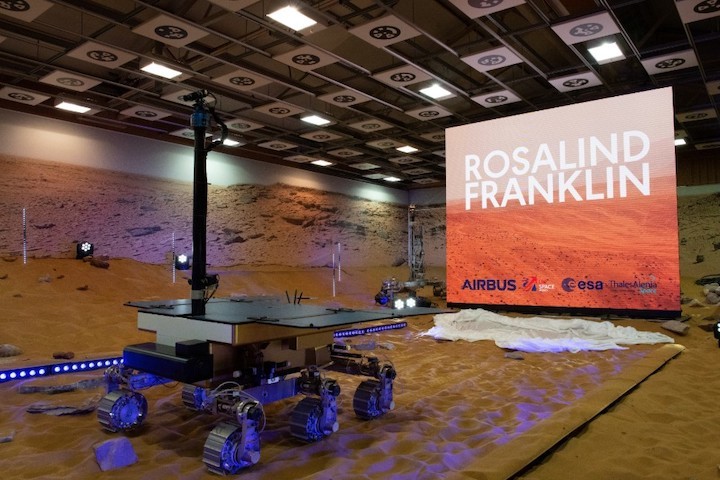
STEPPING STONE
The 2020 mission is the second phase of the ExoMars programme. The first mission launched in 2016 and delivered ESA's Trace Gas Orbiter (TGO), a Martian satellite with a dual role. TGO arrived at Mars in late 2016 and spent a year in "aerobraking" manoeuvres – skimming the atmosphere to slow down enough to gradually reduce is highly elliptical insertion orbit to a broadly circular path for its operational phase.
As its name implies, TGO is scanning the atmosphere to detail its composition more precisely than is possible from Earth or via other orbiters. ESA's still-operational Mars Express, for example, identified traces of methane in 2004. First results from the far more sensitive TGO, published earlier this year, reveal methane in tiny concentrations. Historical observations of methane suggest variation of its atmospheric concentration, so while methane can arise from geological processes, seasonal variation might imply biological origin.
TGO's second purpose is to act as a communications relay, working in conjunction with Mars Express and NASA's Mars Reconnaissance Orbiter. Critically, TGO will be Rosalind's comms link to Earth during its 2021 entry, descent and landing, and the spacecraft is already being manoeuvred to ensure it will be in the right orbit at that critical time.
A second half of the 2016 mission fared less well. To test entry, descent and landing technology for the rover mission, a stationary landing platform named Schiaparelli – after the 19th Century Italian astronomer Giovanni Schiapparelli, who mapped the planet's surface features – accompanied TGO to Mars. The two separated on approach to the planet, but while the orbiter has performed flawlessly, Schiaparelli – designed for the entry, descent and landing test and then to survive on battery power for just a few days to support a science payload – hit the ground hard and was destroyed.
Landing on Mars is notoriously difficult, as the atmosphere is too thin for effective use of parachutes alone but thick enough to demand elaborate shielding to protect a spacecraft from the heat generated as it enters the air at hypersonic speed; parachutes, heat shields and rockets are all needed to land safely. Your correspondent, on the sidelines of the Rosalind naming event, made the mistake of asking Woerner what seemed at the time like a quite reasonable question: was he confident, after the Schiaparelli failure, of getting Rosalind safely to the surface?
"Schiaparelli," he shot back, "was not a failure". This mission was, after all, a test. And, in that test the heat shield worked, the parachute worked, separation of the heat shield and parachute worked, engine start worked. The computer stopped the engine too early, after just 3s instead of 30s – the lander's rate of rotation after about 3min in the atmosphere was high enough to "saturate" the sensors, leading the computer to believe it was below ground level – and so "we had a hard touchdown". But in any case, ESA got all of the data and understands very clearly what went wrong.
In short, Woerner is confident of success in putting Rosalind on the surface.
But he went on to stress that language is critical. The European press, he laments, is quick to talk of "failure". Compare coverage in Europe and the USA of SpaceX's first attempts to recover, by fly-back and soft landing, a Falcon 9 rocket booster. In the UK and Europe, flames-smoke-kaboom was "failure" – but the US press shouted: "Almost!" In Europe, urges Woerner, "we have to change our culture".
PRESSING AHEAD
Meanwhile, Rosalind may have a name but work continues apace to make her ready to fly. Multiple shifts have been working in Stevenage to build and test a flight-ready rover, and its surface science platform has been delivered from Russia to Italy for integration with the German-built carrier module that will ultimately transport all the pieces to Mars on board a Russian Proton-Breeze rocket. David Parker, ESA's director of human and robotic spaceflight, told FlightGlobal in Stevenage that 1,000 people in Europe are associated with this project. ESA alone has 40 people dedicated to it and a budget of €150m ($165m per year).
Ultimately, ExoMars is a triumph of international co-operation. The programme dates to early-2000s European concepts for Mars exploration, but was derailed in 2011 when cash-strapped partner NASA – the launch and transit-to-Mars provider – had to drop out. Fortunately, Roscosmos soon stepped in with Proton rides for both segments and some scientific payloads.
Then, with the TGO-Schiaparelli mission already in deep space, the 2018 follow-up wobbled over cost worries and concerns that the hardware would not be ready in time. The 2018 launch was pushed back to 2020 – Mars and Earth are at their closest every two years. Speaking at Stevenage, Woerner warmed to a favourite theme, praising the Russian partnership; despite the "Earthly crisis" that may seem to characterise today’s east-west geopolitics, it is right to work together.
Beyond ExoMars – and no-one would head a space agency without a penchant for looking to the future – Woerner says the dream remains to send astronauts to our nearest celestial neighbour. However, he stresses, there is much work to be done.
Critically, we need the technical ability to bring a crew home in the event of mishap. Where the Apollo 13 mission could avert tragedy by flying its stricken spacecraft around the Moon to return home in a couple of days, no such flightplan is possible for a crew that finds itself in trouble months away in deep space. We also need to understand much better some basic science, such as the radiation risk to a Mars mission crew, , Woerner adds.
Ultimately, he notes, for Apollo 11 there was a 50% chance of success – and we would never take such risks today. A human mission to Mars will happen, but not soon.
And, he says, when it does happen – or when it starts to look possible – we cannot resurrect the Apollo notion of a space race. Co-operation, he says, is the future. Competition is a driver, but "co-operation is an enabler".
Quelle: FlightGlobal


